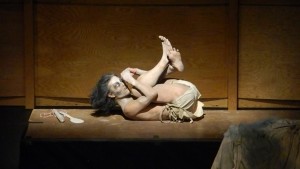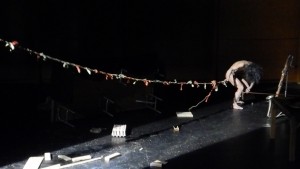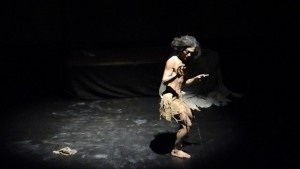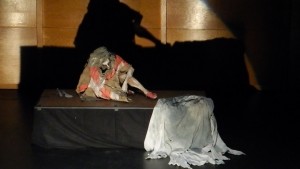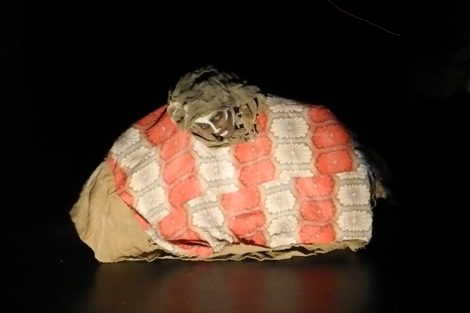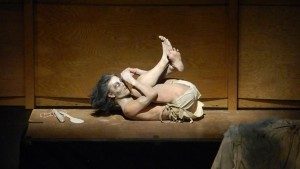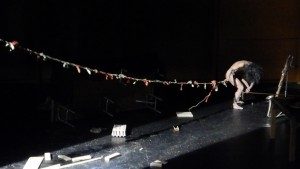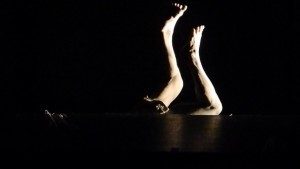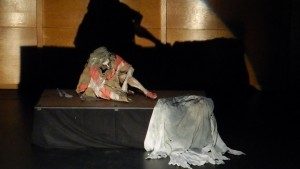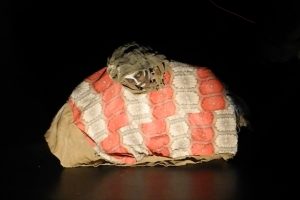November 19: Stray Birds with Taketeru Kado
November 19, 7:30 p.m.November 19, 7:30 p.m.
Stray Birds
Stray Birds is a riveting improvised movement-and-music performance by internationally known Japanese performer Taketeru Kudo and acclaimed experimental musician Michael Pestel. It is a rare opportunity to see butoh—a modern Japanese dance-and-movement form that emerged from post World War II Japan. An acclaimed performer of the new generation of butoh, Kudo will be in residence at Lafayette in mid November. His movements are unusually fluid and frequently compared to those of a bird. The title is inspired by the poetry collection
Stray Birds by Rabindranath Tagore, 1916
St r a y B i r d s
Butoh Movement, Sound and Sediment
Notes From the Above Ground
Michael Pestel
Stray Birds, Taketeru Kudo and Michael Pestel, are unpredictably caged and uncaged. They are unmercifully cunning, but also perfectly capable of hamming it up, three wings to the wind, when the moment is right. Mostly, however, they are fluttering continents apart. When they do meet, in their vast lateral migrations between East and West, they have no choice but to resuscitate their avian collaboration from the ground up. Even their unchanging title, stolen from Rabindranath Tagore’s dreamlike collection of aphorisms (Stray Birds, 1916), must be rediscovered and recalibrated each time they meet.
Writing now, as I wait for my stray counterpart to return after a two- or three-year absence, Tagore’s poetic gems illuminate my thoughts in sudden, phosphorescent bursts. They are, at turns, fireflies . . . flycatchers . . . firebirds.
Stray birds of summer come to my window to sing and fly away. And yellow leaves of autumn, which have no songs, flutter and fall there with a sigh.
S o m e H i s t o r y
Although he will shrug off accolades of any kind, Kudo-san may be the most sublime ghost of the new generation of butoh dancers. His movements are unusually fluid for butoh, more like a bird than the zombie kinesthetics of butoh’s notorious netherworld. Early on, he studied with Akiko Motofuji, the widow of Tatsumi Hijikata, the father of butoh in the postwar era; later, he also studied with Koichi Tamano, Hijikata’s first student. In the nineties, he toured for five years with Sankai Juku, the company that put butoh on the world stage with a fatal accident, in Seattle, in 1985. In the late nineties, Kudo went solo—alone on stage without distraction—and founded his own school, Tokyo Gui-En-Kan. Kudo-san has performed often in Russia and Europe. Recently, in Moscow, he was the solo dancer in The Full Moon, which won the Golden Mask, Russia’s most prestigious National Theater award. Kudo-san is a prodigious reader of dark Russian novels. Audiences from Vladivostok to Paris adore him!
Like Cage and Cunningham, Kudo and I are equal but separate partners. Cage and Cunningham, however, were absolute sticklers when it came to following musical scores and choreographic diagrams. Neither of them, it seems, was particularly interested in improvisation, nor did they trust improvisation as a vehicle for chance encounters of any kind, not even the bird kind. Theirs was an Apollonian, classical approach, and a more or less repeatable—to the extent that any performance is repeatable—intersection of two separate and independently through-composed art forms. In this sense, their collaborative works, although chance-driven in the composition process, were relatively risk-free—that is to say, “non-improvisatory”—when being performed for an audience. The musicians and dancers generally rehearsed separately and allowed their recombinant performance to be a total surprise, both to themselves and their audience. This “surprise”—a radical rethinking of the eternal lockstep marriage of dance and music—was one of modernism’s most important and compelling performance strategies!
Kudo and I prefer as much risk as possible—or at least the illusion of it—in navigating as blindly as possible through a performance. True, there is some discussion in advance, as well as a minimal stage set. But, in the end, we trust only the accumulated sense of each other’s moves. Sometimes, only the lighting engineer is given instructions—e.g., to move the performance gradually from dusk to dawn to dusk, in any way she chooses. In other words, for us the performance happens when control, especially emotional control, is given over to our sense of the moment—of place, audience, and ourselves. Ours is a minimalist Dionysian approach.
Although Kudo and I are a generation apart in age, the discovery of our avian predilections must have overlapped sometime in the nineties. During that decade, while he was touring with Sankai Juku, I performed on Sunday mornings in the vast glass and steel flyway of the Marsh Room at the Pittsburgh Aviary, now known as the National Aviary. Birds named Inca tern, greater flamingo, sun bittern, ruddy duck, crested oropendola, snowy egret, scarlet ibis, blue-winged kookaburra, red lorry, golden concure, roseate spoonbill, hooded merganser, and many others swooped, sang, screeched, chattered, and called throughout their glorious prison. Maybe I was their Johnny Cash. In any case, no symphony could ever match the level of entrained cacophony that these birds achieved . . . unless the orchestra’s preconcert warm-up period could go on and on, and be the performance itself!
One bird, a New Guinea coral-billed ground cuckoo, who was known as Monster, was my constant collaborator. Monster was not an especially great singer, but an extraordinary communicator who, from his perch on the handrail, made guttural eye contact with my flute and stood his ground with a vengeance. As did I. For about a year, we spent hours locked in a call-and-response world of our own, inches from each other, while the rest of the birds in the Wetlands Room looked down from high girders, scampered along the handrails, moved through the foliage, swam in the pond, or whooshed back and forth through the immense space around us.
In the years that followed, my avian reveries increasingly defined the arc of my travels. I spent one long summer night exchanging Aeolian riffs with a solitary sprosser thrush on the edge of Berlin’s Mueggelsee. Hidden away in a grotto of a small Buddhist temple in Kita Kamakura, I performed with a nojiko, a Japanese yellow bunting. An uguisu, or Japanese nightingale, accompanied me every night for two weeks when I lived in a dense forest on the edge of Mt. Asama, a dormant, smoldering volcano looming over Karuizawa. On the Canary Island of Lanzarote, I practiced glissandos with a flock of lesser short-toed larks on a high cliff overlooking the ocean toward Africa. Wind-borne sand from the Sahara swirled around my face and the resonant sounds of an exuberant oceanic ensemble. More recently, I accompanied David Rothenberg, musician and philosopher, to play with lyrebirds in Australia, in the rain forest at Lamington National Park near Brisbane, and also in the eucalyptus groves outside of Melbourne. In Lamington, we concertized with one lyrebird in particular named George, an Albert’s lyrebird, the very same bird that Olivier Messiaen had encountered twenty years earlier. Our journey is well-chronicled in David’s Why Birds Sing and in a BBC documentary of the same name. Why indeed! For the same reasons we humans do!
In November 2000, I met Kudo under a large, black umbrella in front of a London hotel. I was there to perform music with a troupe of dancers from Tokyo at the Institute of Contemporary Arts (ICA). Fatefully, Kudo and I were assigned a room together. We bonded over birds and sake. Then, a few days later, we chunneled to Paris and performed six stories underground in an enormous, futuristic white theater at the Japan Cultural Institute, near the Eiffel Tower. But we saved the best for last by giving an impromptu performance for Maya Picasso and her guests at Jean Marc Bustamente’s painting studio. Maya still raves about us fifteen years later.
In the years that followed, I brought Kudo to Chatham College, in Pittsburgh (where I taught art history, sculpture, and sound art), to lead butoh workshops. In Pittsburgh, we performed at Carnegie Mellon University’s Wats:on Festival, in the Mattress Factory Art Museum’s brick-walled garden, and at the National Aviary live with birds. In Tokyo, we performed at Die Pratze, an avant-dance venue near the Imperial Palace, and later for Isabelle Huppert at the French Embassy. In Bennington, Vermont, we performed around an enormous bonfire in photographer Kevin Bubriski’s sprawling garden. Kevin has been photographing Kudo in a range of industrial and natural settings for more than a decade. In Middletown, Connecticut, my wind ensemble played on a large octagonal stage in the forest while Kudo climbed trees and crawled along an adjacent stream on a cold October day. Kudo is a master sake drinker.
O troupe of little vagrants of the world, leave your footprints in my words.
S o m e T h o u g h t s
Performing with an avian ghost is not easy. It requires deadly concentration mixed with a touch of whimsy and nearly scatological outbursts of sound and movement woven thick with silence. This is butoh—Kudo-san caught between stealth and tantrum, and I, the muse, teetering between aleatoric calm and holy hell. Our stage is as bare and as filled as our rule of thumb: Expect nothing, inspect everything. We have rehearsed diligently, but nothing is choreographed or planned except for the meticulously planned absence of planning. Decisions emerge gently or erupt suddenly from raw feeling—gut-wrenching, lice-scratching, satyr-prancing revelations cut as if through onion strata into tears, laughter, and stillness . . . perhaps a kind of resuscitated death.
The mighty desert is burning for the love of a blade of grass
who shakes her head and laughs and flies away.
Amagatsu Ushio, the founder of Sankai Juku, said that, unlike most forms of dance, “Butoh is a dialogue with gravity.” Rather than seeking to escape the earth’s pull, butoh “synchronizes and sympathizes” with gravity. Thus, Kudo’s heroic attempts at avian flight are always aborted. Right after liftoff, he might stumble clip-winged to the ground . . . and just as quickly resume his lunatic fancy for flight by pawing dementedly at the air. Likewise, Kudo’s royal, anatomical splendor will buckle suddenly into crippling terror and uncertain fear—and then, just as confidently, sweep back up to splendor.
Or consider the way in which the cloak-swept motion of a cod-pieced king un-hyphenates itself just long enough to become a beggar’s hobble, then resumes the gold-crowned rooster’s stride again as if nothing had happened. In fact, the forms of tension and release are endless: limpness rising, effort collapsing, flying, falling. This is Kudo’s standard gravity-bound vocabulary of motion, a kind of slippage that never finds a point of static balance. Equally uncertain is the when and where of an endpoint for the performance. In some cases, the escape hatch will come in waves of exhaustion and fade out incrementally; in others, it will writhe out excrementally, violently, suddenly.
It is the tears of the earth that keep her smiles in bloom.
We are told that such extreme dialectics emerged out of Japan’s postwar crisis, that butoh was formed directly from the ashes of an emperor’s confession. It seems that Antonin Artaud had heard those same clairaudient confessions in a Parisian madhouse some twenty years earlier and prepared the world for the Cold War’s avant stage of the fifties, or, more specifically, for the diverging stages of butoh’s founders: Tatsumi Hijikata and Kazuo Ono. Since capitalism has merely redirected Japanese military discipline, as well as a horrific sense of loss, into the vicious cycle of consumer production and consumption, the crisis that butoh confronted sixty-five years ago remains more or less the same today—perhaps even more stuck in the Japanese craw than ever.
The historian or critic can studiously languish along these lines, but Kudo-san shrugs it off as pure distraction from the work at hand. “I am not a butoh dancer,” he says, trying to set the record straight. “I am nothing. Just becoming. Becoming bird.” What counts for Kudo and for myself is the blank slate: the stage as nowhere. No Hijikata Tatsumi. No Ono Kazuo. No John Cage or Merce Cunningham. Just becoming bird by crawling broken on the ground of contradiction.
If you shed tears when you miss the sun, you also miss the stars.
Terms such as improvisation or free improv, although technically correct, sound glib in the face of the internal provocations aligning and misaligning our performances. Sure, the choreography and music are spontaneous, but they are anything but free. Rather, they are trapped in emotional necessity to the point of being stripped bare, down to the chalk-white body in the awful space between life and death. Some would say that this is butoh ideology in a shrouded nutshell. But such academic ambitions are meaningless to the performer, who must eviscerate himself from the bottom up, along a different path, with each performance.
The sands in your way beg for your song and your movement, dancing water.
Will you carry the burden of their lameness?
For Kudo, the path of most resistance is the one that finds its way back home. The body, pushed along by cemetery winds, must oscillate spasmodically through rattling piles of bones long since picked dry of dreams and identity. His golden body scampers cloven-hoofed in stuttering zigzags within the heated scrutiny and avarice of audience eyes. It is true—I have seen it from the musician’s side of the stage—that an audience’s gluttony for entertainment can melt the body’s loneliness into ingots of despair. But that is their prerogative. It is also a critical point of resistance that Kudo meets head-on. In the end, though, no matter the path of resistance, the body must let go altogether and dissolve into the black, fat air of nothingness. Such are the requirements of butoh . . . and becoming bird.
